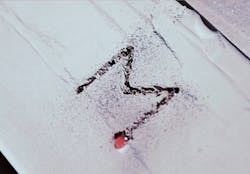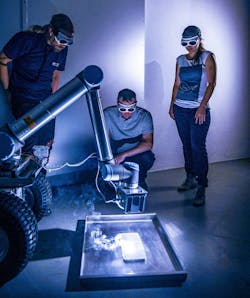Lanes melted with a laser are a first step towards 3D-printed buildings, landing points, and roads made of moon dust. In the MOONRISE project, a team of scientists from the Institute of Space Systems (IRAS) at the Technical University of Braunschweig (Braunschweig, Germany) and Laser Zentrum Hannover (LZH; Hannover, Germany), an independent, nonprofit research institute, have succeeded in both melting regolith (the layer of unconsolidated rocky material covering bedrock) under lunar gravity and “printing” joint lanes.
At the end of the two-year project funded by the Volkswagen Foundation, laboratory experiments were carried out with the MOONRISE laser on the IRAS rover’s robot arm. The scientists succeeded in melting moon dust into joint lanes. The robot arm controlled the LZH laser head, similar to how it could be used on the moon in the future.
Niklas Gerdes, a scientific employee at LZH, states, “In the last two years, we have developed a laser head that is only about the size of a large juice box and yet can withstand the adverse conditions in space. During the first tests in the laboratory, we determined the necessary irradiation duration and laser power. Then, we went into the vacuum chamber and successfully melted regolith there.” Throughout the project, the IRAS scientists adapted the regolith's composition to the landing site’s expected conditions.
A highlight was the experiments in the Einstein Elevator at Leibniz Universität Hannover (LUH); MOONRISE was the first-ever scientific experiment in the elevator. According to Prof. Dr.-Ing. Ludger Overmeyer, LUH/LZH, “In the Einstein Elevator, we succeeded in melting regolith into spheres—both under complete weightlessness and under lunar gravity. That is unique in the world!”A grand finale was the use of the laser on the IRAS rover MIRA3D, a mobile platform and a robot arm used to develop additive manufacturing technology on the Moon. IRAS scientists were able to precisely control the laser head on the arm of the rover and melt larger structures precisely.
The next milestone after the project would be to develop the laser head into a flight model. LZH and IRAS are currently in talks with relevant agencies to push ahead with the developments.

